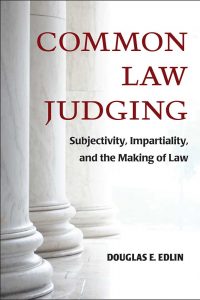A Reading List for Understanding the U.S. Supreme Court

This week the University of Michigan Press presents a reading list of titles that focus on the proceedings of the United States Supreme Court. Through the exploration of specific rulings, amendments, and procedures, these books help to demystify some of the more opaque aspects of the judicial process, particularly as they relate to topics such as marriage equality, transgender rights, confirmation hearings, and more.
This list includes only a selection of our books on these topics, and we encourage you to explore more of our titles on law and political science and to follow us on Twitter ( @UofMPress ) for updates about our books.
Elite-Led Mobilization and Gay Rights by Benjamin George Bishin, Thomas J. Hayes, Matthew B. Incantalupo, and Charles Anthony Smith
Media and scholastic accounts describe a strong public opinion backlash—a sharply negative and enduring opinion change—against attempts to advance gay rights. The authors of Elite-led Mobilization and Gay Rights argue that this perceived backlash is in fact elite-led mobilization—a strategy used by anti-gay elites, primarily white evangelicals, seeking to prevent the full incorporation of LGBTQ Americans in the polity in order to achieve political objectives and increase their political power. This book defines and tests the theories of Mass Opinion Backlash and Elite-Led Mobilization by employing a series of online and natural experiments. Taken together, the evidence shows that opposition to LGBTQ rights is a top-down process incited by anti-gay elites rather than a bottom-up process described by public opinion backlash.
The Chief Justice , edited by David J. Danelski and Artemus Ward
The Chief Justice brings together leading scholars of the courts who employ social science theory and research to explain the role of the Chief Justice of the U. S. Supreme Court. They consider the chief justice’s appointment, office, powers, and influence both within the Court and in the American system of government more generally. The chief justice presides over oral arguments and the justices’ private conferences. The chief justice speaks first in those conferences, presents cases and other matters to the other justices, and assigns the Court’s opinions in all cases in which the chief justice votes with the majority. In addition, the chief justice presides over the Judicial Conference of the United States, a policy-making body composed of lower-court federal judges.
As Chief Justice Charles Evans Hughes wrote, the Chief Justice of the U. S. Supreme Court is “the most important judicial officer in the world. ”
Common Law Judging by Douglas E. Edlin
Are judges supposed to be objective? Citizens, scholars, and legal professionals commonly assume that subjectivity and objectivity are opposites, with the corollary that subjectivity is a vice and objectivity is a virtue. These assumptions underlie passionate debates over adherence to original intent and judicial activism.
In Common Law Judging , Douglas Edlin challenges these widely held assumptions by reorienting the entire discussion. Rather than analyze "judging" in terms of objectivity and truth, he argues that we should instead approach the role of a judge’s individual perspective in terms of intersubjectivity and validity. Drawing upon Kantian aesthetic theory as well as case law, legal theory, and constitutional theory, Edlin develops a new conceptual framework for the respective roles of the individual judge and of the judiciary as an institution, as well as the relationship between them, as integral parts of the broader legal and political community. Specifically, Edlin situates a judge’s subjective responses within a form of legal reasoning and reflective judgment that must be communicated to different audiences.
The Poverty Law Canon , edited by Marie A. Failinger and Ezra Rosser
The Poverty Law Canon takes readers into the lives of the clients and lawyers who brought critical poverty law cases in the United States. These cases involved attempts to establish the right to basic necessities, as well as efforts to ensure dignified treatment of welfare recipients and to halt administrative attacks on federal program benefit levels. They also confronted government efforts to constrict access to justice, due process, and rights to counsel in child support and consumer cases, social welfare programs, and public housing. By exploring the personal narratives that gave rise to these lawsuits as well as the behind-the-scenes dynamics of the Supreme Court, the text locates these cases within the social dynamics that shaped the course of litigation.
Noted legal scholars explain the legal precedent created by each case and set the case within its historical and political context in a way that will assist students and advocates in poverty-related disciplines in their understanding of the implications of these cases for contemporary public policy decisions in poverty programs. Whether the focus is on the clients, on the lawyers, or on the justices, the stories in The Poverty Law Canon illuminate the central legal themes in federal poverty law of the late 20th century and the role that racial and economic stereotyping plays in shaping American law.
Supreme Court Confirmation Hearings in the U. S. Senate by Dion Farganis and Justin Wedeking
Critics claim that Supreme Court nominees have become more evasive in recent decades and that Senate confirmation hearings lack real substance. Conducting a line-by-line analysis of the confirmation hearing of every nominee since 1955—an original dataset of nearly 11,000 questions and answers from testimony before the Senate Judiciary Committee—Dion Farganis and Justin Wedeking discover that nominees are far more forthcoming than generally assumed. Applying an original scoring system to assess each nominee’s testimony based on the same criteria, they show that some of the earliest nominees were actually less willing to answer questions than their contemporary counterparts. Factors such as changes in the political culture of Congress and the 1981 introduction of televised coverage of the hearings have created the impression that nominee candor is in decline. Further, senators’ votes are driven more by party and ideology than by a nominee’s responsiveness to their questions. Moreover, changes in the confirmation process intersect with increasing levels of party polarization as well as constituents’ more informed awareness and opinions of recent Supreme Court nominees.
Inconsistency and Indecision in the United States Supreme Court by Matthew P. Hitt
The United States Supreme Court exists to resolve constitutional disputes among lower courts and the other branches of government, allowing elected officials, citizens, and businesses to act without legal uncertainty. American law and society function more effectively when the Court resolves these ambiguous questions of Constitutional law. Since lower courts must defer to its reasoning, the Court should also create clear and consistent legal doctrine, giving a reason for its judgment that a majority of justices support.
Despite this ideal, it is almost inevitable that a Court that prioritizes resolving a large number of disputes will occasionally create contradictory opinions. Conversely, if a Court prioritizes logically consistent doctrine, they will be unable to handle as many cases. Inconsistency and Indecision in the United States Supreme Court demonstrates that the Supreme Court historically emphasized the first goal of dispute resolution but evolved into a Court that prioritizes the second goal of logically consistent doctrine. As a result, the Court today fails to resolve more underlying questions in law and society in order to minimize criticism of its output from other elites. In so doing, the modern Court often fails to live up to its Constitutional obligation.
Transgender Rights and Politics , edited by Jami K. Taylor and Donald P. Haider-Markel
To date, media and scholarly attention to gay politics and policy has focused on the morality debates over sexual orientation and the legal aspects of rights for non-heterosexuals. However, transgender concerns as such have received little attention. As transgender activism has become more visible, policymakers, both in the United States and around the world, have begun to respond to demands for more equitable treatment.
Jami K. Taylor and Donald P. Haider-Markel bring together new research employing the concepts and tools of political science to explore the politics of transgender rights. Volume contributors address the framing of transgender rights in the U. S. and in Latin America. They discuss transgender interest groups, the inclusion of transgender activists in advocacy coalitions, policy diffusion at the state and local levels, and, importantly, the implementation of transgender public policy. This volume sets the standard for empirical research on transgender politics and demonstrates that the study of this topic can contribute to the understanding of larger questions in the field of political science.
In Contempt by Ed Yellin and Jean Fagan Yellin
“YOU ARE HEREBY COMMANDED to be and appear before the Committee on Un-American Activities of the House of Representatives of the United States, or a duly appointed subcommittee thereof, on February 10 (Monday), 1958, at ten o’clock a.m. at City Council Chambers, City Hall, Gary, Indiana, then and there to testify touching matters of inquiry committed to said committee, and not to depart without leave of said committee.”
So began a decade of hardship for Ed and Jean Yellin and their three young children as the repressive weight of the U. S. government, caught up in the throes of McCarthyism, crashed down upon their careers, their daily household budget, and their relationships to colleagues, neighbors, and their country. In Contempt is a faithful, factual testament to the enduring quality of patriotic dissent in our evolving democracy—and a loving reconstruction of what it meant to be labeled “unAmerican” for defending the Constitution.
The Limits of Legitimacy by Michael A. Zilis
When the U. S. Supreme Court announces a decision, reporters simplify and dramatize the complex legal issues by highlighting dissenting opinions and thus emphasizing conflict among the justices themselves. This often sensationalistic coverage fosters public controversy over specific rulings despite polls which show that Americans strongly believe in the Court’s legitimacy as an institution. In The Limits of Legitimacy , Michael A. Zilis illuminates this link between case law and public opinion. Drawing on a diverse array of sources and methods, he employs case studies of eminent domain decisions, analysis of media reporting, an experiment to test how volunteers respond to media messages, and finally the natural experiment of the controversy over the Affordable Care Act, popularly known as Obamacare. This meticulously constructed study and its persuasively argued conclusion advance the understanding of the media, judicial politics, political institutions, and political behavior.
Forthcoming:
Still a Hollow Hope by Anthony D. Cooling
The U. S. Supreme Court increasingly matters in American political life when those across the political spectrum look at the Court for relief from policies they oppose and as another venue for advancing their own policy agendas. However, evidence is mounting that courts are more of a sideshow to the culture war. While court decisions, especially Supreme Court decisions, do have importance, the decisions emanating from the Court reflect social, cultural, and political change that occurred long prior their decision ever being made.
This book tests how much political and social change has been made primarily through Gerald Rosenberg’s framework from his seminal work, The Hollow Hope: Can Courts Bring about Social Change , but it also utilizes Daniel Elazar’s Political Culture Theory to explain state level variations in political and social change. The findings indicate that while courts are not powerless institutions, reformers will not have success unless supported by the public and the elected branches, and most specifically, that preexisting state culture is a determining factor in the amount of change courts make. In short, federalism still matters.













